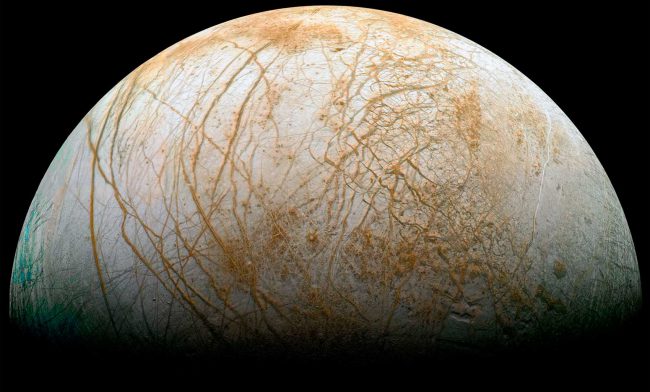If there is life in the solar system beyond Earth, then it is most likely in the sub-icy oceans of Europa or Enceladus. There, hypothetical organisms have quite comfortable conditions: the necessary chemical elements and protection from radiation in the form of a thick layer of ice. That same ice also makes them difficult to find, but according to a new paper, the chemical components of cells (amino acids) may have been stored on its surface for millions of years.
The search for extraterrestrial life (and perhaps civilizations) has fascinated people for centuries. Unfortunately, all attempts so far have failed, and this does not stop scientists. Moreover, there is still a chance to find organisms living outside the Earth, but within the boundaries of the Solar System.
The prime candidates for habitation are, of course, the icy moons of the gas giants, such as Europa (a moon of Jupiter) and Enceladus, which orbits Saturn. They have no significant atmosphere and are in very harsh conditions, but they have vast oceans of liquid water beneath their surfaces. Despite being far from the Sun, the interiors of Europa and Enceladus are heated by tidal forces from the gravitational pull of massive Jupiter and Saturn, respectively.
Both icy moons are subject to cryovolcanism – the eruption of volcanoes in low-temperature conditions. The moons may also contain carbon brought by comets and other elements necessary for the origin of life. Phosphorus has also been discovered on Enceladus. For this reason, both cosmic oceans continue to attract the attention of astrobiologists searching for signs of extraterrestrial life. They are interested in biomarkers, or biosignatures, such chemicals or other signs that indicate the presence of living organisms.
If life did indeed begin on Europa or Enceladus, it wouldn’t be easy to reach it through miles of ice. But biomarkers are also expected to be found in oceanic ice sheets or in cryovolcano emissions. For example, near the south pole of Enceladus, there is a magnificent “fountain” from which ice and other impurities fall into space. But both approaches present challenges. The first is during ice drilling, and the second is when a sample is properly captured by a spacecraft.
The authors of a new article in the journal Astrobiology decided to experimentally find out how high the chances of biomarkers surviving on the surface of the moon were. They recreated the conditions on Europa and Enceladus in the laboratory using liquid nitrogen and gamma radiation.
The authors suggested that gamma rays, although the dominant radiation in space, destroy organic matter in much the same way as particle radiation. Therefore, Europa’s surface is bombarded primarily by high-energy electrons, as well as protons from Jupiter’s radiation belts. At the same time, the giant shields its moon from radiation from galactic sources. Meanwhile, for Enceladus, radiation from outside the Solar System is more important; primarily protons and alpha particles, i.e. helium nuclei.
The object of the research was individual amino acids – glycine and isovaline (which terrestrial cells do not use). Some pure preparations were mixed with ice (there is no shortage of them on Europa and Enceladus), others were placed in quartz glass media. They also used the remains of dead bacteria – Escherichia coli Escherichia coli and Acetobacterium woodii, which is very different from it. All samples are sealed in glass tubes without air intake and immersed in a special container containing liquid nitrogen. It has a temperature of about -196 degrees Celsius, which is about the same as the surface of icy moons.
The frozen tubes were then irradiated. The radiation doses absorbed by the samples were enormous: one, two, three or four megagrams (millions of grays). For comparison: 10-15 grays is more than enough to kill a person. As a result of such treatment, the glass of some test tubes cracked or even exploded.
The study of surviving test tubes showed that after a dose of up to one megagray, pure amino acids were not destroyed. Even after four megagrays, glycine was not reduced, but isovaline was reduced by about 40 percent. At the same time, preparations of pure amino acids in quartz glass were destroyed much more rapidly than those surrounded by water ice.
It was observed that the amino acid content in dead E. coli preparations gradually decreased with increasing radiation dose. The drugs behaved differently A. woodii — The dependence of their concentration on the dose is described by a step curve. After rapid destruction at a dose of one megagray, they did not break down further even at the maximum level of radiation. At the same time, 85 percent of amino acid molecules survived after irradiation with a dose of three megagrams, with the exception of the more sensitive arginine and histidine.
The authors concluded that biomarkers such as amino acids could be stored for millions of years in the ice near the surface of Europa (at a depth of about 20 centimeters). At the same time, we are talking about areas of the hemisphere of the moon that is always facing Jupiter, which are weakly bombarded by meteors. On Enceladus, amino acids could be stored directly on the surface and elsewhere on the moon.













